DigitalStorm Enix: Phenomenal Cosmic Power, Itty Bitty Living Space
by Dustin Sklavos on May 12, 2011 12:00 AM EST- Posted in
- Systems
- Intel
- Sandy Bridge
- SilverStone
- DigitalStorm
Application and Futuremark Performance
Given this is the fastest i7-2600K we've tested, one of the fastest graphics configurations on the market, and one of the fastest SSDs available, it's not unreasonable to expect the Enix we have on hand will top every one of our performance tests.
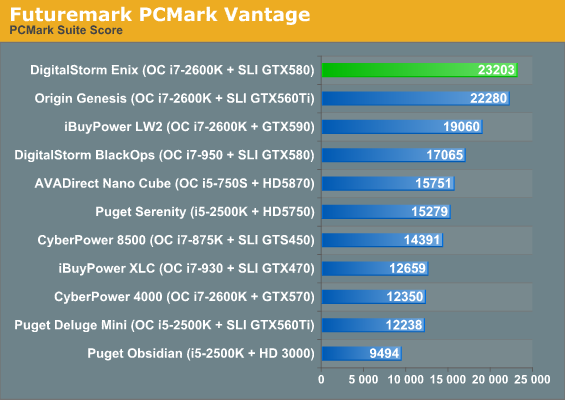
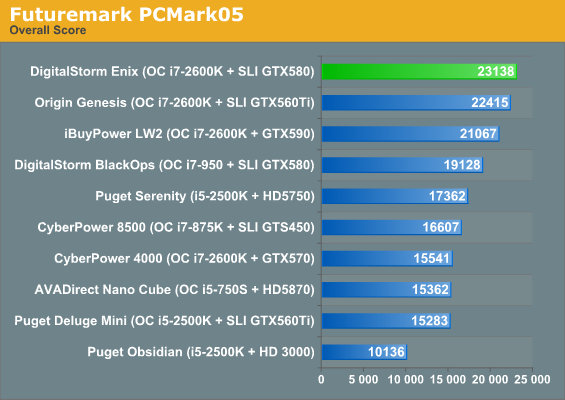
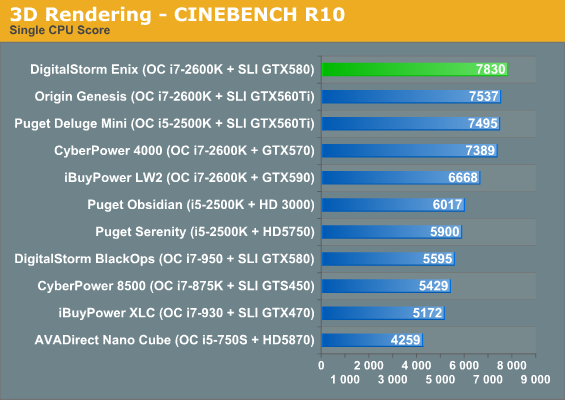

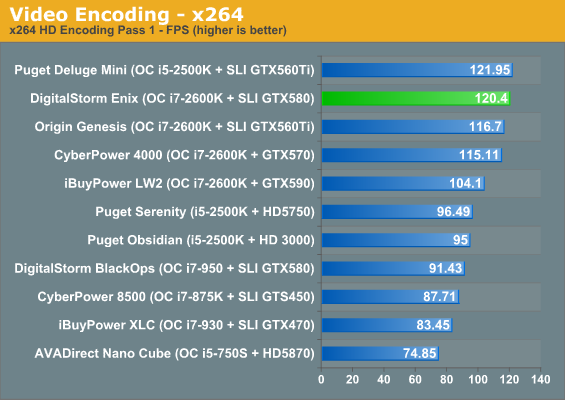
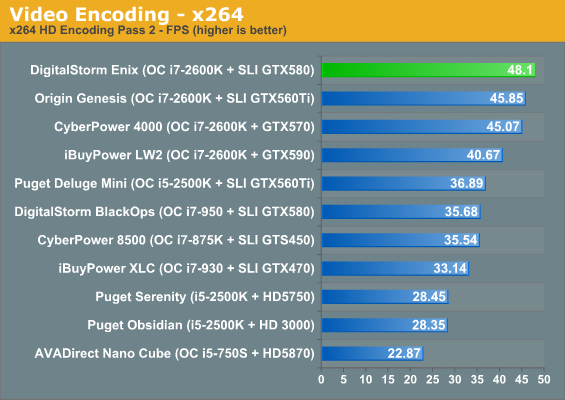
Apart from a minor hiccup in the first pass of our x264 encoding suite (close to being within the margin of error), the Enix shows up pretty much everywhere you'd expect it to be: the top of each chart. 3DMark should be no less kind.
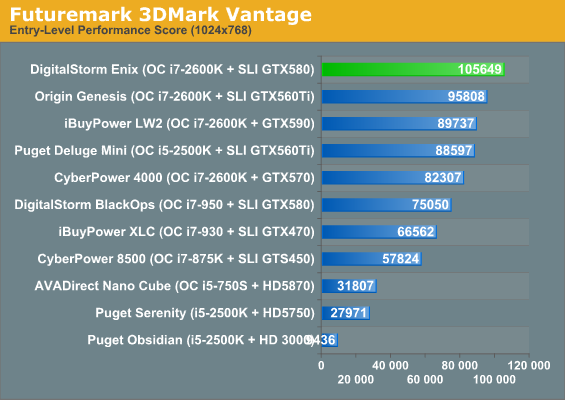
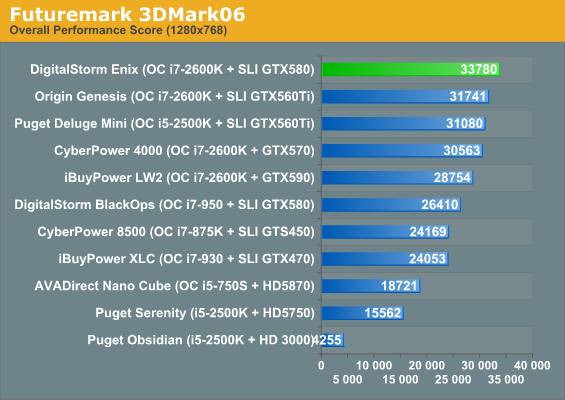
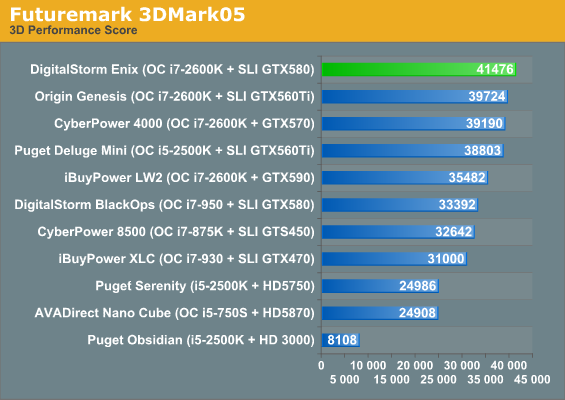
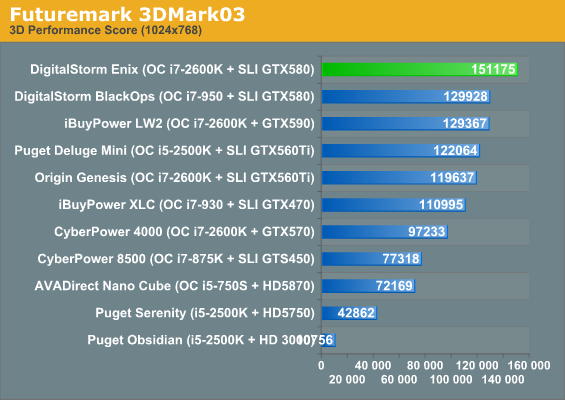
Yeah, it's more or less a bloodbath. The Enix's massive overclock and SLI NVIDIA GeForce GTX 580s take on all comers. But you already knew this was going to be the fastest machine we've yet tested, so the next page chock full of gaming benchmarks should be purely academic, right?










32 Comments
View All Comments
HilbertSpace - Thursday, May 12, 2011 - link
Where's the noise results?Spazweasel - Friday, May 20, 2011 - link
Seconded. Something's missing!ckryan - Thursday, May 12, 2011 - link
If Digital Storm is willing to back up their systems with a 10 yr CPU warranty, then why all the hand wringing? 10 years is a long, long, time. Kudos to them for such a far reaching commitment. If they say it's all good, >1.5v for short periods of time is acceptable, then who am I to argue?Really though, I'm blown away by the decade long CPU warranty. That's just crazy, and I don't know how they're going to honor it 9 years in (but I'd like to know). Props to DigitalStorm for having the balls and the foresight for what amounts to marrying their customers.
bji - Thursday, May 12, 2011 - link
I agree with everything you say; but I wonder how frequently CPUs fail? I personally have *never* had a CPU fail, and I've owned more than a dozen. Others on this site have undoubtedly owned more than I have. Anecdotal evidence anyone?I have an old VIA Samuel 2 based system that I bult in 2002 that is still chugging away in a corner making nightly backups of my server. About 5 years ago the CPU fan died and I didn't bother to replace it. The CPU sits at a constant 50C - 60C, and if I do anything intense (which is almost pointless given how slow it is, but occasionally I drop a bunch of videos on it from my digital camera and let it chew on re-compressing them, which takes hours/days but I don't really care as it's not time critical), it gets up to 80C or so.
And yet, 9 years on, it's still going strong. Nothing on that system has ever died, not even the hard drive. It's a P.O.S. PCChips motherboard and it's just been completely flawless for 9 years now.
I have high confidence that just about any CPU will last 10 years easily, but maybe others have different experiences.
slacr - Thursday, May 12, 2011 - link
The first and only thing that would fail is the capacitors for the CPU-PWM supply on the motherboard, I wonder if this would be considered "cpu related".While I won't argue with them on what v-core is right and what's not, i remember Anand having an article a couple of months back on "what is a reasonable overclock", basically you generally hit a wall where v-core requirements start going up sharply for small clock increases and a good practise is to place yourself at or just below that kink in the curve.
I have the same motherboard and case as this digitalstorm, albeit with a 2500k cpu. While i haven't spent any time tweaking it the built in "oc automation" that i accidentally activated placed it at 4.4 Ghz and 1.29 V peak v-core. I have a really hard time seeing how those 300 extra Mhz are worth yet another 0.2 V, but i guess thats how you end up with chart-topping benchmarks.
JarredWalton - Thursday, May 12, 2011 - link
I will agree that I've had a LOT more failed motherboards over the years, but I've definitely burned out CPUs with overclocking. It usually shows up initially as performance degradation--a CPU that would overclock to 3.4GHz becomes unstable, and you have to drop the overclock down to 3.0GHz for example. I had that happen with a Pentium D 920 as well as an earlier Pentium 4; eventually the only way that CPU would run at all was to underclock it (but still with higher voltage than spec). I had a couple AMD Athlon X2 chips take a similar route, one socket 939 and another was one of the first AM2 chips.Anyway, it does happen, and the best way to do it is overly high voltages. That said, I've never burned out a CPU running it at stock. They become really slow compared to modern CPUs, but as long as the motherboard (and RAM, GPU, etc.) don't fail the processors almost never go out running stock clocks.
Hargak - Thursday, May 12, 2011 - link
This ^ is what I've seen, reminds me of a dimming lightbulb you have to crank it up to a higher voltage to get the same result. your burning out transistors at a certain rate which if you run something like Super Pi you can see the processing power degrade even though clocks are the same. Strange anomilies which change with architecture and process.slacr - Friday, May 13, 2011 - link
Are you sure these are not just issues with ripple on the supply side to the CPU (i.e any measurements, swapping motherboard or the like).I'm not saying i'm sure of this, it's just in line with my experience. But I've only dabbled in small temporary OC's with jumpers on socket 939 and the like. The only long time experiences i have are with Core2Duo/Quad and now a short stint of Sandy. My experience with a Core2Quad for example saw unstability develop (after initially having proven prime95 stable over 24 hrs) at 3.6 Ghz on a p35 motherboard at 1.37 V over 1.5-2 years, when that was swapped out for an Asus board all was fine again at the same frequencies with slightly lower voltage. Now this might be that the Asus board simply was more stable, but the processor had not seen any degradation.
How older architectures are affected I don't know, I just wonder if you've verified that it is in fact the processor and not something else.
MilwaukeeMike - Thursday, May 12, 2011 - link
A warrantee will replace your CPU at it's current replacement cost, not the original purchase. So in 5 years when the performance of a 2600K is $90, it won't be so hard. In 8 years it'll be less.Anyone buying this now will probably upgrade long before it's up, so the effective range of the warranty is probably only around 3 years.
ckryan - Thursday, May 12, 2011 - link
Can you buy a new Pentium 3 today? You could ten years ago. It'd be a little harder today. In the year 2021 I would imagine 2600k's aren't falling of of trees; I'm sure it would be harder to honor than it sounds. In the near term it's expensive, in the medium term they'll get cheaper and cheaper, then in six years become very hard to find. So they have to stockpile them, replace the CPU and motherboard with a newer version, or Intel has agreed to make the socket 1155 for the rest of eternity. I was just curious about the practical ramifications of what I consider a silly long time for a warranty for a component. Kudos to DigitalStorm.